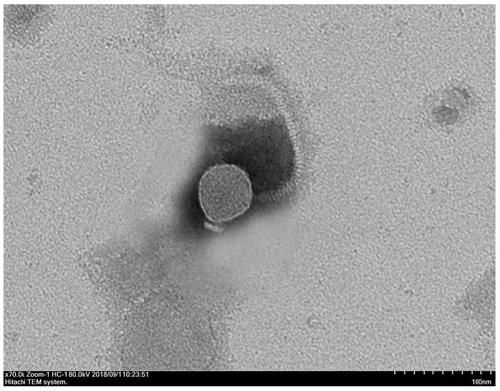FSN17-1 Photobacterium damselae phage FSN17-1 and application
A technology of photobacteria and mermaids, applied in the field of bioengineering, can solve the problems of narrow cleavage spectrum, etc., and achieve the effects of fast proliferation, high application value and commercial value, and convenient fermentation and large-scale production
- Summary
- Abstract
- Description
- Claims
- Application Information
AI Technical Summary
Problems solved by technology
Method used
Image
Examples
Embodiment 1
[0035] The isolation and preparation of embodiment 1 phage
[0036] The host bacterium of the phage used in the experiment of the present invention is the clinical isolate NDA12 of Photobacter mermaidi (GenBank accession number is MK285669).
[0037] The sample of the present invention is the peritoneal content of large yellow croaker with diseased disease collected from Sanduao, Ningde City, Fujian Province. After the sample is cut into pieces, it is dissolved in 15 mL of SM liquid, centrifuged at 12000 rpm for 20 min, and then the supernatant is filtered with a 0.22 μm filter membrane. Take 10 mL of the filtered supernatant, add 0.5 mL of the overnight culture of the host bacteria, and then add sterile CaCl 2 Mix the mother liquor to a final concentration of 1.25mM, add 20mL of 2216E medium, place it in a 30°C incubator and cultivate it for 6-8h, then take the above culture at 12000rpm, centrifuge for 30min, and take the supernatant; then take 10mL of the supernatant, Add 0...
Embodiment 2
[0040] Amplification and purification of embodiment 2 phage
[0041] On the double-layer plate that formed phage plaques in Example 1, use the tip of a pipette to pick up a single phage plaque with a larger diameter, inoculate it in 5mL 2216E medium, and add the host bacterial solution in the logarithmic growth phase 0.1mL, mix well, act at room temperature for 15min, incubate at 30°C for 12h, centrifuge at 12000rpm, 4°C for 10min, take supernatant, add 0.3% chloroform. Repeatedly pick 4-5 single phage plaques in this way until the phages are purified into phage plaques of the same size.
[0042] Take 1 mL of freshly cultured host bacteria and add 0.5 mL of phage lysate (the ratio of a single phage culture to host bacteria is 1:1, 1:10 and 1:100, respectively). Incubate at 30°C for 20 minutes to make the phage particles adsorb to the host bacteria; add 100mL 2216E liquid medium, then add CaCl 2 The final concentration of the mother liquor was 1.25mM, shake culture at 30°C fo...
Embodiment 3
[0047] The influence of embodiment 3 temperature and pH on bacteriophage
[0048] Take 0.1mL 1×10 9 pfu / mL purified phage FSN17-1 (provided in Example 2) acted in a 30-90°C water bath for 30min or 60min respectively, and measured its titer after the sample was cooled; 8 Pfu / mL purified phages were mixed in equal amounts, and the potency was measured after 2 hours in a water bath at 30°C.
[0049] The effect of temperature on the survival of bacteriophage image 3 shown by image 3 It can be seen that the activity of phages did not change significantly after being treated at 30-60°C for 30 minutes or 60 minutes respectively; after being treated at 70°C, the titer of phages decreased significantly; after being treated at 80°C for 1 hour, no phage survived.
[0050] The effect of pH on phage survival Figure 4 shown by Figure 4 It can be seen that when the pH is 3.0, no surviving phage can be detected; when the pH is 4.0 and 11.0, the phage is still alive, but the titer is ...
PUM
| Property | Measurement | Unit |
|---|---|---|
| Diameter | aaaaa | aaaaa |
| Head diameter | aaaaa | aaaaa |
Abstract
Description
Claims
Application Information
 Login to View More
Login to View More - R&D
- Intellectual Property
- Life Sciences
- Materials
- Tech Scout
- Unparalleled Data Quality
- Higher Quality Content
- 60% Fewer Hallucinations
Browse by: Latest US Patents, China's latest patents, Technical Efficacy Thesaurus, Application Domain, Technology Topic, Popular Technical Reports.
© 2025 PatSnap. All rights reserved.Legal|Privacy policy|Modern Slavery Act Transparency Statement|Sitemap|About US| Contact US: help@patsnap.com



